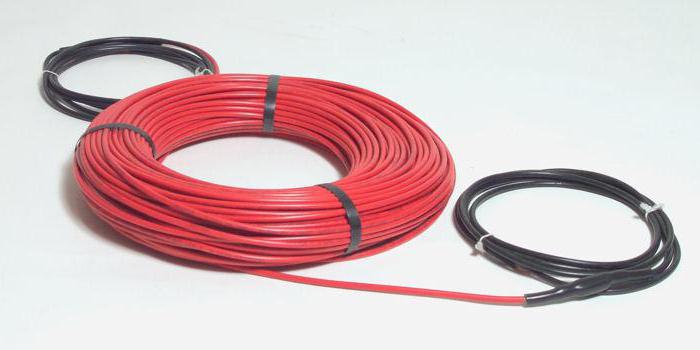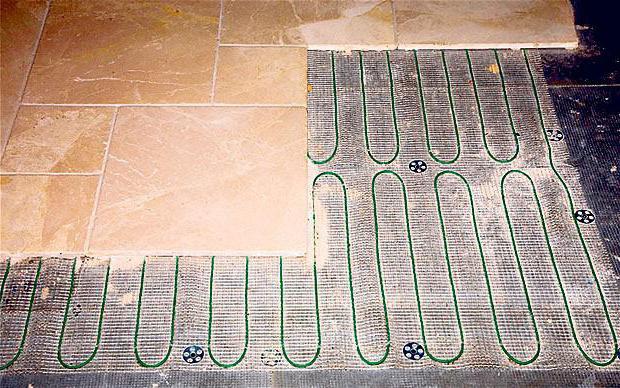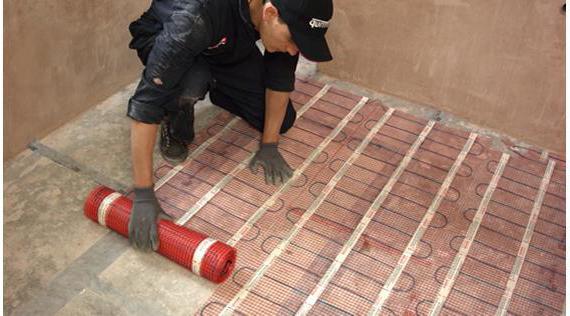Sections of the site
Editor's Choice:
- How to unlock ariston washing machine
- Pros and cons of LED lighting
- Pulse relay: device and connection
- How to calculate the illumination of a room with LED lamps?
- Plastic box - do-it-yourself aesthetic view of electrical wiring
- Electricity consumption of a warm floor: electric and film
- Installing a pump in a well: how to properly install pumping equipment
- Electrician Toolkit Overview
- How to choose a water heater: the most complete list of evaluation criteria
- 1 acoustics on the example of Sven SPS-860 and Realtek ALC889 codec
Advertising
| Underfloor heating electric, electricity consumption: owner reviews |
|
With the onset of cold weather, each owner seeks to heat his home with high quality with minimal energy costs. Therefore, recently such heating as electric floor heating is gaining popularity. Electricity consumption, according to manufacturers, is quite small. But there are several conditions that affect the energy consumption of such systems. Consumer reviews will allow you to draw the right conclusions and equip a warm floor with minimal operating costs. Only with proper installation, the system will be able to fully heat the room, while spending a minimum of electricity. Principle of operationThe electric wire used for heating consists of a nichrome core and various insulating sheaths. Such devices must be mounted in a solution. A layer of screed or tile adhesive heats up and gives off heat to the floor covering. Laminate, tile or other materials at the same time become similar to the heated surface of the convector. Only heating, unlike such an electrical appliance, occurs according to a different principle. The convector sends streams of heated air up. At the ceiling in this case, the maximum temperature is determined. Cold masses accumulate at the base of the room. The warm floor of which is often smaller than that of a convector, creates heat at the bottom of the room. At the ceiling, the air is colder. Therefore, this type of heating is more comfortable for a person. Purpose of the systemToday, a large number of types of electric are on sale. With their help, you can create both comfortable and autonomous heating. In the first case, the area of the room is covered by less than 50% of the wire system or film. In this case, an additional device (battery, convector) is used for heating. Full heating of the room without the use of additional devices allows you to create a warm electric floor. Electricity consumption, reviews of which are provided by experts, can be minimal. In this case, the spent energy resources will be spent optimally. It should also be said that with the help of a film underfloor heating it is not necessary to create autonomous heating. Such systems are designed for comfortable heating. Types of systemsThe power consumption depends on the type of system. The most commonly used varieties are cable, mat and film. In the first version, the heating element is supplied in a coil. On a special bar, the installer lays out the wire independently. In this case, the laying step is from 7 to 15 cm. The thicker the wire is mounted, the more from 1 m², as well as heat transfer. A wire with a cross section of about 7 mm is poured into a screed 3-5 cm thick. The mat system is already assembled with a certain pitch on a PVC mesh. These are underfloor heating under electric tiles. Their electricity consumption is fixed. The mat is laid under 5-8 mm of tile adhesive. The diameter of such a wire is approximately 3 mm. Film underfloor heating also has a fixed power. This system is mounted under a laminate, linoleum without the use of a solution. Power selectionIn order for the underfloor heating to heat the room, it is necessary to set sufficient power per 1 m². This parameter is in the range from 110 to 180 W / m² for rooms. Street heating requires 2 times more power. The presented indicator is influenced by the characteristics of the room. The higher the level of heat loss in it, the more powerful the system will be required. If the windows, floor and walls are insulated, the ceiling is of standard height (no more than 2.7 m), a low-power system is suitable. But for cold rooms, in which heat loss is significant, it is required to increase the heating. Sometimes it is necessary to set the power up to 300 W/m². For this, a special electric underfloor heating is used. Electricity consumption in a garage, for example, will be much higher than in an apartment in a multi-storey building. If the flooring will be made of laminate in a room with minimal heat loss, the power of the system should be 110-130 W / m². For a balcony, a bathroom where tiles will be installed, this figure is increased to 150-180 W / m². Carrying out power calculationIn order to correctly select and install an electric underfloor heating, the electricity consumption of which will not hit the family budget, it is necessary to make a preliminary calculation. First, select the required power per 1 m². For example, it will be a bathroom in an apartment on the 2nd floor (there are neighbors downstairs who heat the room), where the flooring will be made of tiles. The power consumption of the system will be 150 W/m². If we discard the area on which the furniture, plumbing is located, the square is 3 m². So, a warm floor is required like this: 150 x 3 = 450 watts. The wire footage is selected based on this indicator. This is the optimal power at which a given room will be heated at minimal cost. Temperature controlThe presented calculation allows you to determine the indicator of the maximum power of the system. As a rule, the operating temperature of the heating wire is 65°C. The floor will not heat up to this level, since there are certain heat losses in the room. But 50-55º C with good insulation of the base, the system will be able to give out on the surface. It is comfortable for a person to stand with bare feet on a surface heated to 25-28ºС. To maintain this level, a warm floor is connected to a thermostat. In this case, the device opens the circuit when the user-specified heating is reached. When the floor cools down a few degrees, the device will turn on the power supply again. Therefore, the system consumes less electricity per hour than indicated on the package. |
New
- Tonsillitis in adults - what is it, symptoms and treatment, causes, photos and first signs What is throat tonsillitis
- Diseases of the male genital area Chronic inflammatory diseases of the female genital area
- Signs of gastric and duodenal ulcers
- Prostate cancer of the fourth stage: the possibilities of modern medicine
- What is useful lemon water for weight loss, face, hair
- How to talk to a girl and not seem boring What is the best way to communicate with girls
- Foods rich in zinc
- Is the treadmill an indispensable exercise machine or just a complicated toy?
- Kievan Rus: education and history
- What vitamins are good for facial skin?











